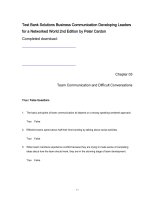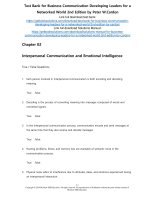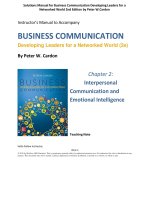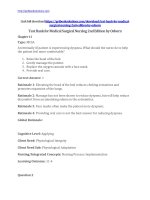test bank for business communication developing leaders for a networked world 2nd edition by cardon 180314092803
Bạn đang xem bản rút gọn của tài liệu. Xem và tải ngay bản đầy đủ của tài liệu tại đây (721.99 KB, 92 trang )
Test Bank for Business Communication Developing Leaders for a
Networked World 2nd Edition by Peter W.Cardon
Link full download test bank:
/>Link full download Solutions Manual:
/>
Chapter 02
Interpersonal Communication and Emotional Intelligence
True / False Questions
1.
Each person involved in interpersonal communication is both encoding and decoding
meaning.
True
2.
False
Decoding is the process of converting meaning into messages composed of words and
nonverbal signals.
True
3.
False
In the interpersonal communication process, communicators encode and send messages at
the same time that they also receive and decode messages.
True
4.
False
Hearing problems, illness, and memory loss are examples of semantic noise in the
communication process.
True
5.
False
Physical noise refers to interference due to attitudes, ideas, and emotions experienced during
an interpersonal interaction.
2-1
Copyright © 2016 McGraw-Hill Education. All rights reserved. No reproduction or distribution without the prior written consent of
McGraw-Hill Education.
True
6.
False
All outgoing messages are encoded and all incoming messages are decoded through a filter
of lifetime experiences.
True
7.
High self-awareness includes the ability to manage events that stir strong responses.
True
8.
False
Venting negative feelings is one of the most effective strategies for de-escalating anger.
True
9.
False
False
People who have low self-management should practice self-talk to improve.
True
False
10. People with high self-management react defensively with a me-first attitude when threats are
perceived.
True
False
11. Recent business-school graduates rank listening skills among the most important
communication skills.
True
False
12. In a conversation with a co-worker, Kosuke agrees with everything the other person says.
Kosuke is successfully practicing the skill of holding judgment.
True
False
2-2
Copyright © 2016 McGraw-Hill Education. All rights reserved. No reproduction or distribution without the prior written consent of
McGraw-Hill Education.
13. During a conversation with his supervisor, Alec paraphrases something that he heard her say.
This is an example of a judger statement.
True
False
14. Sharing your own ideas with your colleagues undermines the active listening process.
True
False
15. Probing questions are intended to create bonds between people.
True
False
16. Leading questions are generally open-ended.
True
False
17. Nonverbal messages, such as posture, are most important when they convey a different
emotion than the spoken message.
True
False
18. A person's motivational value system is a blend of the three primary motives of nurturing,
dominating, and autonomizing.
True
False
19. A manager who wants to hire an effective leader should focus on applicants who are
extroverts.
True
False
2-3
Copyright © 2016 McGraw-Hill Education. All rights reserved. No reproduction or distribution without the prior written consent of
McGraw-Hill Education.
20. When one is treated poorly, responding aggressively potentially de-escalates a difficult
situation and shows one's character and caring.
True
False
Multiple Choice Questions
21. Which of the following terms best describes the process of sending and receiving verbal and
nonverbal messages between two or more people?
A. active listening process
B. verbal communication process
C. interpersonal communication process
D. thought process
E. review process
22. Melissa intends to say something to the new employee that will make him feel welcome as a
member of the team. The thought that Melissa intends to communicate is known as _____.
A. meaning
2-4
Copyright © 2016 McGraw-Hill Education. All rights reserved. No reproduction or distribution without the prior written consent of
McGraw-Hill Education.
B. message
C. semantics
D. encoding
E. empathy
23. _____ is the process of converting meaning into messages composed of words and nonverbal
signals.
A. Decoding
B. Encoding
C. Translating
D. Filtering
E. Communicating
24. Ayesha says, "You're so generous!" in a sarcastic tone. Mario decides that Ayesha thinks he is
cheap. What process has Mario just done?
A. filtering
2-5
Copyright © 2016 McGraw-Hill Education. All rights reserved. No reproduction or distribution without the prior written consent of
McGraw-Hill Education.
B. hijacking
C. encoding
D. synchronizing
E. decoding
25. Loud music coming from the next room or distorted formatting in an email message are
examples of _____ noise.
A. physical
B. psychological
C. semantic
D. physiological
E. cognitive
26. _____ noise occurs when communicators apply different meanings to the same words or
phrases.
2-6
Copyright © 2016 McGraw-Hill Education. All rights reserved. No reproduction or distribution without the prior written consent of
McGraw-Hill Education.
A. Psychological
B. Physical
C. Semantic
D. Cognitive
E. Physiological
27. Which of the following is an example of psychological noise?
A. Jenna's boss does not understand what she tells him because his hearing aid battery dies.
B. Jenna's boss does not understand that when she says a product is "bad," she means she
likes it.
C. Jenna's boss does not take her complaint seriously because construction noise prevented
him from hearing it.
D. Jenna's boss does not take her complaint seriously because he thinks teenagers always
exaggerate.
E. Jenna's boss does not remember what she tells him because he has another meeting right
after their conversation.
2-7
Copyright © 2016 McGraw-Hill Education. All rights reserved. No reproduction or distribution without the prior written consent of
McGraw-Hill Education.
28. All outgoing messages are encoded and all incoming messages are decoded through
A. a filter of lifetime experiences.
B. psychological noise.
C. mitigating
information.
D. a motivational value system.
E. sight-reading.
29. Emotional _____ refers to a situation in which emotions control our behavior causing us to
react without thinking.
A. filtering
B. hijacking
C. blackmail
D. noise
E. intelligence
2-8
Copyright © 2016 McGraw-Hill Education. All rights reserved. No reproduction or distribution without the prior written consent of
McGraw-Hill Education.
30. Which of the following is the process of accurately understanding one's own emotions as
they occur and how they affect one's behavior and thought?
A. self-management
B. empathy
C. relationship management
D. shared
meaning
E. self-awareness
31. Events that cause strong emotional reactions are called _____.
A. triggers
B. stressors
C. noise
D. distracters
2-9
Copyright © 2016 McGraw-Hill Education. All rights reserved. No reproduction or distribution without the prior written consent of
McGraw-Hill Education.
E. filters
32. Jeanne pays close attention to her emotions at work and takes a quick break whenever she
thinks her frustration level might cause her to lash out at a co-worker. What quality does this
behavior demonstrate?
A. empathy
B. self
-management
C. emotional hijacking
D. sight
-reading
E. psychological noise
33. Which of the following involves the discipline to hold off on current urges to meet long-term
intentions?
A. empathy
B. self
-awareness
C. self
-management
2-10
Copyright © 2016 McGraw-Hill Education. All rights reserved. No reproduction or distribution without the prior written consent of
McGraw-Hill Education.
D. relationship management
E. sight-reading
34. Which of the following domains of emotional intelligence is the "ability to accurately pick up
on emotions in other people and understand what is really going on with them"?
A. empathy
B. relationship management
C. self
-management
D. self
-awareness
E. pessimism
35. Which of the following is an impact of low self-management on interpersonal
communication?
A. One directs conversations to topics that are important to self.
B. One focuses exclusively on the task at hand without paying attention to rapport
-
building.
C. One provides indirect and vague feedback and ideas to others.
2-11
Copyright © 2016 McGraw-Hill Education. All rights reserved. No reproduction or distribution without the prior written consent of
McGraw-Hill Education.
D. One frequently vents frustrations without a constructive work purpose.
E. One is unaware of his or her own emotional states and its related impacts on
communication.
36. Which of the following is an impact of high self-management on interpersonal
communication?
A. One controls emotional impulses that are not aligned with work and relationship goals.
B. One attempts to understand the feelings, perspectives, and need
C. One engages in a me
s of others.
-first approach to work with colleagues.
D. One accepts and even welcomes feedback and constructive criticism.
E. One is aware of triggers and related tendencies to say the wrong thing.
37. Which of the following is an impact of high empathy on interpersonal communication?
A. One controls emotional impulses that are not aligned with work and relationship goals.
B. One directs conversations to topics that focus on the needs of others and self.
2-12
Copyright © 2016 McGraw-Hill Education. All rights reserved. No reproduction or distribution without the prior written consent of
McGraw-Hill Education.
C. One is aware of triggers and related tendencies to say the wrong thing.
D. One spends a higher percentage of work conversations on work
-related topics with
a focus on solutions.
E. One frequently vents frustrations without a constructive work purpose.
38. Juan tries to build rapport with the people on his project by checking in with them each day
to see if they have any questions or concerns. What aspect of emotional intelligence does this
behavior demonstrate?
A. high empathy
B. h igh self-awareness
C. high relationship management
D. low self -management
E. low empathy
39. Which of the following is a strategy to improve relationship management?
A. Engage in relaxation techniques to clear your mind.
2-13
Copyright © 2016 McGraw-Hill Education. All rights reserved. No reproduction or distribution without the prior written consent of
McGraw-Hill Education.
B. Practice self-talk and visualize yourself responding effectively to challenging interpersonal
issues.
C. Constantly evaluate your feelings and moods ; attempt to understand your feelings as they
occur.
D. Build up the courage to have a difficult conversation.
E. Reflect on personal strengths, weaknesses, and values.
40. Which of the following is a strategy to improve self-management?
A. Encourage others who rarely speak up to voice their thoughts and feelings.
B. Think about group dynamics and
the related impacts on each team member.
C. Examine strategies for overcoming impulses that compete with achieving your long
-
range goals.
D. Think about your last reactions to the following experiences: joy, anger, self
-doubt,
frustration.
E. Attend work-related social outings.
41. Which of the following is most likely to be true of those people who have low empathy?
2-14
Copyright © 2016 McGraw-Hill Education. All rights reserved. No reproduction or distribution without the prior written consent of
McGraw-Hill Education.
A. They often repress their emotions and then respond inappropriately to situations.
B. They seize any opportunity
to talk about their own past accomplishments.
C. They frequently use meeting time to complain about issues unrelated to the current task.
D. They go out of their way to explain company procedures to new co
-workers.
E. They listen carefully to what others say and then ask questions to clarify what they heard.
42. Which of the following is a domain of emotional intelligence?
A. shared meaning
B. sympathy
C. self
-management
D. semantics
E. synchronizing
43. When Jamie listens to a customer, she maintains eye contact, nods when appropriate, and
ignores her phone when it gives an incoming message alert. Which active listening skill is she
using?
2-15
Copyright © 2016 McGraw-Hill Education. All rights reserved. No reproduction or distribution without the prior written consent of
McGraw-Hill Education.
A. reflecting
B. holding judgment
C. summarizing
D. clarifying
E. paying attention
44. Which of the following is an example of the active listening skill of clarifying?
A. Trung leans slightly forward as he listens to others.
B. Trung asks questions that demonstrate his desire to understand other
points of view.
C. Trung asks the other person to explain a point more completely.
D. Trung expresses his own perspective after he has heard the other person.
E. Trung pauses to think about what he has heard and then paraphrases it.
2-16
Copyright © 2016 McGraw-Hill Education. All rights reserved. No reproduction or distribution without the prior written consent of
McGraw-Hill Education.
45. In a meeting with a supplier, Janice listens to his sales pitch and then says, "So the two main
advantages of this product are that it will save us money and it is better for the environment.
Is that correct?" What active listening skill has Janice used?
A. clarifying
B. paying attention
C. reflecting
D. summarizing
E. sharing
46. Which active listening skill involves demonstrating a learner mindset rather than a judger
mindset?
A. holding judgment
B. paying attention
C. reflecting
D. summarizing
2-17
Copyright © 2016 McGraw-Hill Education. All rights reserved. No reproduction or distribution without the prior written consent of
McGraw-Hill Education.
E. sharing
47. Which of the following statements is a judger statement rather than a learner statement?
A. Aren't you interested in trying new techniques?
B. How long do you think it will take to implement this
new program?
C. What do the studies indicate the environmental impact will be?
D. How much do you estimate this will cost?
E. What other companies have tried this type of sales campaign?
48. Which barrier to effective listening involves neglecting listening because of pressing
deadlines?
A. lack of time
B. lack of patience and attention span
C. image of leadership
D. communication technology
2-18
Copyright © 2016 McGraw-Hill Education. All rights reserved. No reproduction or distribution without the prior written consent of
McGraw-Hill Education.
E. fear of bad news or other uncomfortable information
49. A series of questions that attempt to deconstruct a business issue by moving from general to
specific are known as _____ questions.
A. rapport-building
B. funnel
C. probing
D. closed
E. solution-oriented
50. Sylvie starts her weekly department meetings by asking questions such as, "How was your
vacation?" "Did anyone see the football game last night?" and "Who wants to go to lunch
after we finish here?" What type of questions are these?
A. closed
B. rapport -building
C. solution -oriented
2-19
Copyright © 2016 McGraw-Hill Education. All rights reserved. No reproduction or distribution without the prior written consent of
McGraw-Hill Education.
D. probing
E. funnel
51. Customers have been complaining about the products produced by Derek's department. His
team has checked all the equipment, but they cannot find the cause of the poor quality.
What kind of questions would most help them with this issue?
A. solution-oriented
B. rapport -building
C. probing
D. closed
E. funnel
52. What is the main difference between probing questions and solution-oriented questions?
A. Probing questions move from general to specific, while solution-oriented questions move
from specific to general.
B. Probing questions tend to be analytical and focused, while solution
-oriented questions
tend to be casual and social.
2-20
Copyright © 2016 McGraw-Hill Education. All rights reserved. No reproduction or distribution without the prior written consent of
McGraw-Hill Education.
C. Probing questions tend to be closed,
while solution-oriented questions tend to be
open-ended.
D. Probing questions seek to uncover root causes, while solution
-oriented questions focus
on what should be done.
E. Probing questions tend to have a judger mindset, while solution-oriented questions tend
to have a learner mindset.
53. The act of anticipating intentions and moods through the perceptive examination of
nonverbal cues is known as _____.
A. sight-reading
B. emotional intelligence
C. shared meaning
D. relationship management
E. self-management
54. What does research consistently demonstrate about nonverbal communication?
2-21
Copyright © 2016 McGraw-Hill Education. All rights reserved. No reproduction or distribution without the prior written consent of
McGraw-Hill Education.
A. People are not good at masking their feelings, and most people are highly skilled in their
ability to decode nonverbal signals.
B. People are not good at masking their feelings, but most people are incapable of decoding
nonverbal signals.
C. People are good at masking their feelings, but most people still manage to decode
nonverbal signals.
D. People are good at masking their feelings, so most people are incapable of decoding
nonverbal signals.
E. People are not good at masking their feelings, but most people are inconsistent in their
ability to decode nonverbal signals.
55. During a budget meeting, Eva concludes her part of the talk and points to her presentation
partner. What does this gesture most likely mean in context?
A. She is indicating that it is his turn to speak.
B. She is accusing him of interrupting her.
C. She is blaming him for
the poor budget numbers.
D. She is giving him permission to ask a question.
E. She is trying to get him to be quiet.
2-22
Copyright © 2016 McGraw-Hill Education. All rights reserved. No reproduction or distribution without the prior written consent of
McGraw-Hill Education.
56. When Leo had to tell Tania that her project had lost its funding, he found himself adopting a
slumped posture that was similar to hers. What was Leo doing?
A. synchronizing body language to mock her
B. synchronizing body language to show empathy
C. faking a mood to change her emotions
D. using visual cutoff to encourage sharing
E. using visual cutoff to make the conversation end
57. Kim is a salesperson who has learned to gauge her customers' interest from their eyes. Which
of the following is most likely to indicate that her customer is carefully considering her
product?
A. small, constricted pupils in the eyes
B. an abrupt look away by the eyes
C. a rapid sideways movement of the eyes
D. a lengthy sideways movement of the eyes
2-23
Copyright © 2016 McGraw-Hill Education. All rights reserved. No reproduction or distribution without the prior written consent of
McGraw-Hill Education.
E. fast blinking of the eyes
58. Which motivational value system is most often guided by concerns that business activities
have been thought out carefully and the right processes are put into place to accomplish
things?
A. red MVS
B. yellow MVS
C. blue MVS
D. green MVS
E. hub
59. Which of the following statements best expresses a typical concern of someone with a blue
MVS?
A. "Let's make sure everyone feels included in the decision-making."
B. "Let's be sure that we have thought out the long
-term results of this."
C. "Let's consider the most efficient way to implement th
is decision."
2-24
Copyright © 2016 McGraw-Hill Education. All rights reserved. No reproduction or distribution without the prior written consent of
McGraw-Hill Education.
D. "Let's look at how this relates to the overall welfare of the company."
E. "Let's act in a way that provides clear leadership to others."
60. Focusing on _____ is most likely to help you communicate with a red MVS in a way that he or
she prefers.
A. feelings
B. results
C. teamwork
D. flexibility
E. caution
61. Claire and Raul disagree about a proposal for the company to adopt flexible work schedules.
Claire wants to make sure that they have thoroughly investigated other companies that have
such schedules, while Raul wants to make the change happen before summer. What can you
deduce about Claire and Raul?
A. Claire is a green MVS; Raul is a blue MVS.
B. Claire is a red MVS
; Raul is a hub.
2-25
Copyright © 2016 McGraw-Hill Education. All rights reserved. No reproduction or distribution without the prior written consent of
McGraw-Hill Education.









